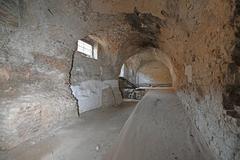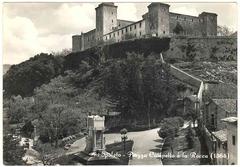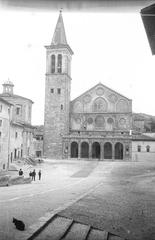
Spoleto: Where Umbrian Magic Dances in Every Street
Date: 04/07/2025
Begin your Spoleto adventure with a secret: this city doesn’t just exist in Umbria—it performs. Ancient stones hum with opera, secret tunnels whisper legends, and truffle-scented breezes hint at mischief. Cue the spotlight, cue the fanfare: Spoleto is about to steal the show. Imagine a place where every cobblestone is a drumroll for a thousand-year performance, and each piazza is a stage for tales of gladiators, popes, poets, and wild boar stew. Welcome to Spoleto, Umbria’s living theater, where ancient arches frame your memories and every meal feels like a standing ovation.
From the aroma of wild thyme to the distant echo of a jazz quartet rehearsing in a Roman theater, Spoleto seduces your senses. Here, time folds in acts—each street an episode, each local a character, and every meal a curtain call. You might stumble into a festival in mid-passeggiata or find medieval graffiti (cat doodles included!) left by a bored guard. This is a city where all senses have starring roles, and legends—like the Lombard duke who hid in an olive barrel or the ghostly applause in the old theater—are woven into daily life as much as a perfectly poured caffè.
Spoleto isn’t content to rest on its obvious charms. Beyond the Duomo’s rose windows and the Rocca’s imposing ramparts, alleys hum with secrets, markets buzz with local banter, and “singing stairs” harmonize with your footsteps. Whether you’re scaling the Ponte delle Torri for a panoramic view, deciphering ancient carvings in San Salvatore, or debating gelato flavors at the market, Spoleto invites you to join the cast. (Pro tip: Never order a cappuccino after 11am unless you want to become the villain in a barista’s story!)
Ready to unlock Spoleto’s backstage magic? Grab your curiosity, your comfiest shoes, and your best “spo-LEH-toh.” Let the adventure begin—because in Spoleto, every visitor gets a starring role (Strictly Italy, Go Ask a Local, Our Italian Journey).
Table of Contents
-
Welcome to Spoleto: Where History Takes the Stage
- Setting the Scene: Layers of Time
- Act One: Ancient Footlights & Roman Drumbeats
- Act Two: Medieval Plot Twists & Lombard Legends
- Act Three: Papal Makeovers & Renaissance Revelries
- Act Four: Spoleto Today – Festivals, Flavors, and Secret Corners
- Sample Itineraries
- Myth Busting & Fun Facts
- Quirky Etiquette
- Spoleto FAQ
- Getting There & Getting Around
Welcome to Spoleto: Where History Takes the Stage
Imagine a city where every cobblestone is a drumroll, every archway a curtain, and every piazza whispers, “The show’s about to begin.” Spoleto is Umbria’s theatrical time machine, where Etruscans, Romans, Lombards, popes, and modern artists all compete for your applause. If Indiana Jones and Sophia Loren had a love child, they’d spend their summers here.
Setting the Scene: Layers of Time
Spoleto is a mille-feuille of history. Each stroll peels back layers: Roman bridges, medieval fortresses, Renaissance frescoes, and the lingering aroma of truffle risotto. Locals say, “Here, you don’t just walk through time—you trip on it.”
Act One: Ancient Footlights & Roman Drumbeats
Step into the 1st century BCE. Gladiators flex, toga hems swirl, and you cross the Ponte Sanguinario (“Bloody Bridge”—now more name than reality). Roman Spoletium was a VIP stop on the Via Flaminia, the ancient route between Rome and Ravenna.
- Hidden Roman forum: Seek out columns behind market stalls.
- Mini-Quest: Snap a selfie at the Arco di Druso e Germanico—pronounce it “AHR-ko dee DROO-so eh Jer-MAH-nee-ko.”
- Sensory Snapshot: Hear echoes in the Teatro Romano, smell cool, mossy stones in crypts, and savor pizza bianca from a bakery older than your family tree.
Act Two: Medieval Plot Twists & Lombard Legends
Fast-forward to the 6th century. The Lombards arrive, ambitious and mustachioed. Spoleto becomes their mighty duchy’s capital—a real-life medieval drama.
- Hidden Gem: Basilica di San Salvatore—a UNESCO site, blending early Christian mosaics with mysterious pagan symbols.
- Legend: A Lombard duke once hid from enemies in an olive oil barrel. Spoleto’s history is slippery in more ways than one!
Act Three: Papal Makeovers & Renaissance Revelries
By the 14th century, popes rule, and Spoleto gets a medieval makeover.
- Rocca Albornoziana: A fortress ready to resist invaders or tourists.
- Ponte delle Torri: Picnic under its arches, with thyme and cypress in the air.
- On Screen: The Rocca starred in the 1970 TV miniseries “The Adventures of Pinocchio.”
- Mini-Quest: Find 15th-century guards’ graffiti inside the Rocca (hint: medieval cats!).
Act Four: Spoleto Today – Festivals, Flavors, and Secret Corners
Modern Spoleto fuses high art and everyday magic. Each June and July, the Festival dei Due Mondi transforms the city into a vibrant stage for opera, ballet, and avant-garde theater. Alexander Calder’s sculptures perch by Roman stones, and the city hums with creativity.
-
Spring: Wildflowers and frittata di asparagi.
-
Summer: Festival fever, open-air concerts, and Trebbiano wine under the stars.
-
Autumn: Olive harvest—join a pressing and drizzle green-gold oil on everything.
-
Winter: Misty hills, hearty lentil soup, and chestnut sweets.
-
Local Lingo:
- “Ciao!” – Hello/goodbye.
- “Un caffè, per favore.” – A coffee, please.
- “Che bella Spoleto!” – How beautiful Spoleto!
- “Posso assaggiare?” – Can I taste?
-
Hidden Corners:
- Chiesa di San Ponziano: A crypt where the patron saint is said to whisper wishes.
- Via delle Mura: For sweeping valley views and wild fennel without the crowds.
Sample Itineraries
Time Traveler (Full Day):
- 8am: Espresso at Caffè Tebro.
- 9am: Explore Roman theater and museum.
- 11am: Visit the Duomo for Filippo Lippi’s frescoes.
- 1pm: Lunch on strangozzi with truffle.
- 3pm: Hike the Giro della Rocca.
- 6pm: Aperitivo in Piazza del Mercato.
- 8pm: Festival performance (summer) or wine bar (off-season).
Hidden Gem Hunter:
- Sunrise in Monteluco’s sacred woods.
- Visit San Salvatore, analyze ancient carvings.
- Hunt for the best torta al testo.
- Sketch by Ponte delle Torri.
Myth Busting & Fun Facts
- Myth: Spoleto is just a sleepy hill town.
- Fact: Spoleto’s parties rival Venice—fewer pigeons, more jazz.
- Myth: Ponte delle Torri is Roman.
- Fact: Likely medieval, but undeniably epic.
- Surprise: Audrey Hepburn filmed “War and Peace” here. Spoleto is effortlessly photogenic.
Quirky Etiquette
- Dress modestly in churches—channel Audrey Hepburn, not Adam Sandler.
- Never order cappuccino after 11am.
- Try your Italian—locals appreciate the effort.
- Ask before photographing people, especially at events.
- Avoid high heels on the Rocca’s ramparts.
- Support small shops and markets.
Spoleto FAQ
- Is Spoleto walkable? Yes, if you can handle hills and ancient steps. Underground escalators ease the climb.
- What’s the food like? Truffles, wild boar, and olive oil are musts. Try strangozzi pasta.
- Can I visit outside festival season? Absolutely—enjoy quieter streets and authentic local life.
- How do you pronounce Spoleto? Spo-LEH-toh—with a smile.
- Any famous ghosts? Only friendly ones. Some say a Roman actress applauds in the old theater.
Getting There & Getting Around
- By Train: Direct and scenic from Rome or Perugia.
- On Foot: The historic center is compact; wear sturdy shoes.
- By Car: Park outside the walls and enter on foot.
- Travel Tip: Explore Spoleto’s heart by walking—no better way to experience its rhythm.
Spoleto’s Living Stage: Landmarks, Legends & Festivals
Grand Entrances & Hidden Trapdoors
Duomo di Spoleto
The city’s centerpiece, glowing at sunset, is a masterpiece of architecture and art. Step inside for Lippi’s frescoes and the ethereal resonance of the choir, especially at dusk.
Rocca Albornoziana
This fortress, perched above town, offers panoramic views and a sense of medieval drama. Seek out the secret passage to the Giro dei Condotti trail.
Ponte delle Torri
A monumental bridge with mysterious origins—Roman, medieval, or even more ancient? Walk across for breathtaking vistas and challenge yourself to count its arches.
Vicolo delle Terme
A narrow alley revealing Roman baths, graffiti, and Spoleto’s tightest passage—dare to walk it at midnight?
Roman Theater
Sit on ancient stone, imagine gladiators, or enjoy a jazz concert. Hunt for the carved lion’s head beneath the arches.
Spoleto—A Festival in Every Season
Festival dei Due Mondi
From late June to mid-July, Spoleto’s international festival transforms it into a hub for opera, theater, and art. Even off-season, the city buzzes with creativity and unexpected performances (Travel Begins at 40).
Culinary Hotspots
- Ristorante Apollinare: For romantic, truffle-laced evenings.
- Il Tempio del Gusto: The carbonara is legendary.
- Bar Vincenzo: For caffè corretto and local banter.
- Torta al Testo: Seek at the Wednesday market—pronunciation earns you respect.
Contemporary Art
Check Chiostro di San Nicolò for pop-up galleries and Teatro Caio Melisso for indie concerts. Join spontaneous music sessions—locals welcome newcomers.
Spoleto on Screen
Spot familiar locations from “Don Matteo” and other Italian films. Take a selfie in Piazza del Mercato and feel like part of the scene.
Senses on High Alert
Monteluco Forest
A tranquil retreat above Spoleto, perfect for hiking and discovering the “Lovers’ Balcony” clearing.
Fonti del Clitunno
Relax by emerald springs praised since Roman times—perfect for a picnic with local treats.
Spoleto Scavenger Hunt
- Find the hidden lion’s head in the Roman Theater.
- Sample three flavors of gelato.
- Toast a local with Sagrantino wine.
- Spot a “Don Matteo” filming site.
- Walk under Ponte delle Torri.
Blend In Like a Local
- Passeggiata: The evening stroll—dress to impress.
- Caffè etiquette: Espresso only after 11am.
- Salve! Use this greeting everywhere.
- Market Days: Tuesday and Saturday—arrive early for the best olive oil.
- Dining: Never rush a meal or cut spaghetti.
Intermission: Quirks, Myths & Mind-Blowers
- Some city walls still show Roman chisel marks.
- Ponte delle Torri has inspired poets, painters, and UFO theorists.
- Every gelateria’s pistachio is unique—research is encouraged.
- Seek out the “singing stairs” near Via Brignone for a harmonious surprise.
Finale: Itineraries for Every Star
Half-Day Express Encore:
- Gelato in Piazza del Mercato
- Rocca Albornoziana for panoramic views
- Vicolo delle Terme for Roman history
- Sunset at the Duomo
Two-Day Slow Burn:
- Day 1: Roman Theater, Archaeological Museum, Monteluco hike, passeggiata, aperitivo
- Day 2: Market shopping, stroll medieval walls, visit Fonti del Clitunno, dinner with a view
Quick-Fire FAQ
- Visit without a car? Yes—trains, escalators, and walkable streets make it easy.
- Kid-friendly? Absolutely—fortresses, alleys, and gelato abound.
- Best month? June (festivals), October (truffle season), or anytime for fewer crowds.
- Don Matteo tours? Yes—ask at the tourist office for a map.
Gastronomy and Practical Visitor Tips
Gastronomy—Layers of Flavors, Layers of Stories
Umbrian Cuisine
Spoleto’s cuisine is a celebration of local flavors:
- Olio Extra Vergine di Oliva: Peppery, vivid, and essential—find the city’s oldest press near Porta Garibaldi.
- Strangozzi alla Spoletina: Thick noodles with tomato, garlic, olive oil, or black truffle.
- Torta al Testo: Griddled bread stuffed with herbs or prosciutto—try it with chicory.
- Cinghiale: Wild boar ragù, as legendary as the city itself.
- Truffles: The prized tartufo is celebrated in markets and festivals.
Mini-Quest: Sample gelato at Crispini, Colder, and Il Gelato di Paola; seek out “ricotta e fichi.”
Where to Eat
- Osteria del Matto: Eccentric host, spontaneous serenades.
- Trattoria del Festival: Pre-show dining for locals and visitors.
- La Torretta: Modern takes on Umbrian classics with a view.
- La Bottega del Viandante: Deli-wine bar with poetic sandwiches.
Wine in Spoleto
- Trebbiano Spoletino: Refreshing white.
- Montefalco Sagrantino: Robust, complex red.
Tip: Many enotecas offer free early-evening tastings—Enoteca Properzio is a favorite.
Markets, Festivals & Foodie Adventures
- Friday Market: Hunt for pecorino and acacia honey.
- Spring: Wild asparagus in every dish.
- Summer: Truffle fairs and open-air concerts.
- Autumn: Chestnuts, grape harvest, cozy trattorias.
- Winter: City lights, cinnamon, and roasted nuts.
Practical Tips with a Twist
- Getting There: Trains from Rome or Perugia offer scenic rides.
- Getting Around: Walk or use city escalators for easy navigation.
- Choose-Your-Own Gastronomic Adventure:
- Breakfast: Cornetto at Pasticceria Tebro.
- Market: Find the freshest produce.
- Lunch: Seek a hidden trattoria.
- Afternoon: Tour an olive oil farm (“frantoio”).
- Aperitivo: Spritz at Bar Canasta.
- Dinner: Cinghiale ragù—ask for the local twist.
- Nightcap: Grappa under the stars in Piazza del Duomo.
Local Lingo
- “Buongiorno!” – Good morning.
- “Dove si mangia bene qui?” – Where do you eat well here?
- “Un bicchiere di vino, per favore.” – A glass of wine, please.
- Never order cappuccino after 11am—locals will notice.
FAQ: Spoleto in a Nutshell
- Safe for solo travelers? Yes.
- English spoken? In most places, but Italian earns smiles.
- Best time to visit? Late spring, early autumn, or July for the festival.
- Credit cards? Widely accepted, though cash is handy for markets.
- Free Wi-Fi? Available in cafes, hotels, and some piazzas.
Ready for Your Encore? Discover Spoleto with Audiala
Unlock Spoleto’s stories, secrets, and laughter at every turn. Download the Audiala app for immersive audio tours, interactive quests, and expert local tips. Spoleto isn’t just a place to visit—it’s a living stage where every traveler becomes part of the story.
References and Local Legends
- Strictly Italy: Things to Do in Spoleto
- Travel Begins at 40: Spoleto Festival
- Go Ask a Local: Umbria Travel Guide
- Our Italian Journey: Spoleto
Audiala2024



